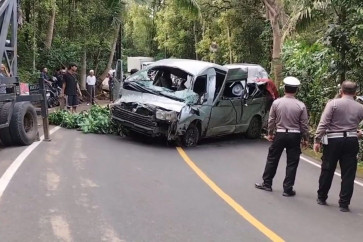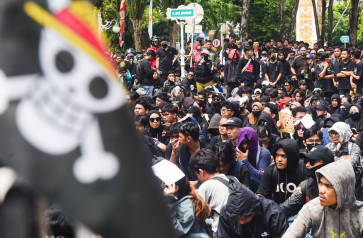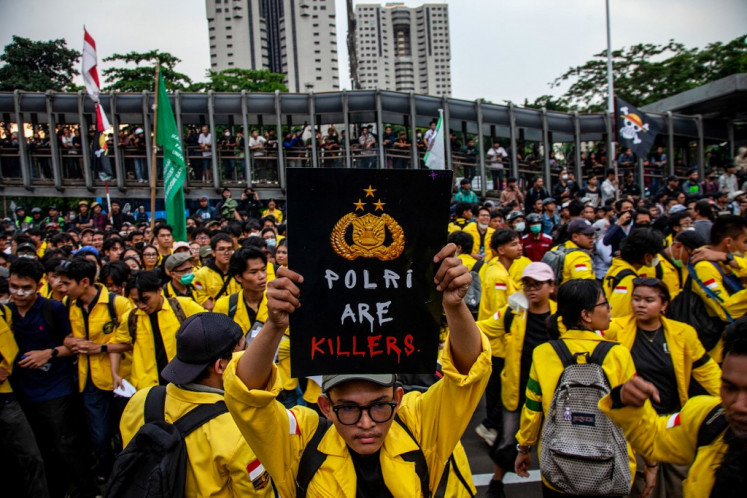Popular Reads
Top Results
Can't find what you're looking for?
View all search resultsPopular Reads
Top Results
Can't find what you're looking for?
View all search resultsDo we have more or less forests today than in the past?
The earth is getting hotter
Change text size
Gift Premium Articles
to Anyone
T
he earth is getting hotter. The climate is becoming more unfriendly. Since the industrial revolution, the culprit of these global trends is the climate change-rooted human consumption of carbon, as climate change science informs us.
This science is basically “reverse engineering” as scientists have looked into the present climate to understand the processes of change over a millennium.
The science has two main objectives: First to reduce the level of carbon consumption and to reverse the process of change through the mitigation of carbon release. Second is to adapt to the changes that are likely to bring harmful effects.
The forestry sector can contribute to achieving these two objectives through regrowing forests to capture the carbon and, once the forest is regrown, providing better ecosystem services to the human population that may prevent floods and support biodiversity.
The question is do we have more or less forest? At the local level, is it truly hotter today? Environmentalists may quickly respond that these are stupid questions.
To be clear, I am a vegetarian and committed to climate mitigation. Below is my experience that reflects the future possibilities of successful reforestation in the small island context of Indonesia.
In the end of 2010, together with a volunteer from Kupang, we had a chance to travel to Alor Island in East Nusa Tenggara (NTT).
Our trip was facilitated by the Alor Red Cross (part of the Netherlands Red Cross support) to see the latter’s climate resilience intervention in Alila Village, Northwest of Alor Island, a village we visited in 2003 together with volunteers from Kupang, NTT.
Alila village is situated between coastal and mountainous areas. The coastal part of the village is often flooded. In 2010 — a La-Nina year with abundant rainfall — a big flood occurred and hit some families.
We always asked two simple questions to children, youths, adults and seniors in the village. Is it hotter today compared with the past? Do we have more or less forests today compared with the past?
We were surprised at the answers we received. For children, youths and adults — including the head of village and a community facilitator, the answers are uniform: “Today the climate is hotter and we have less forest than in the past”. We asked a community facilitator what constituted the past.
“Since our ancestors, our forest has been dense but people have been cutting the trees for firewood and also for housing. So we have less forest today than in the past,” the coordinator said. This narrative is used by the community to explain the fact of frequent flooding in the coastal part of the village.
After the interviews, we met with the former head of the village (about 70-years-old) who was willing to
facilitate our visit to the mountainous part of the village to meet with the head of an elementary school who was working as a teacher for more than 30 years, since the establishment of the school in 1978.
He was one of the teachers who had started the school.
The teacher truly opened our eyes. “I think today we have denser forest than we had in the past. Back in 1960s and early 1970s, Alila used to be a hot place with very little vegetation and was without forest.
“When I first arrived here in 1978, these areas were simply grassland with stones without trees where we experienced bushfires every year.” The head of village — who ruled the village for more than 20 years — also noted that Ben Mboi, the governor who ruled NTT province during 1978-1988, made a strong push for a reforestation program when he took office in 1978.
Governor Mboi asked the community to conserve the land by growing lamtoro (Leucaena leucocephala). Our hosts added “the governor even used airplanes to spread the seeds of lamtoro across the whole region.”
Since then, lamtoro trees have been growing and have gradually been used by villagers to sustain their household energy needs.
As the lamtoro trees became denser, some other big trees also grew. “The problem is that we have too much lamtoro that makes our cash crops, such as cashew trees not producing as the trees block the sunlight,” the school head continued.
In the nearby school, there is a spring surrounded by a few large banyan trees. Local legend suggests that once upon a time, people cut down the trees.
One day, the people who cut the trees were punished by nature and were transformed into small animals that became the prey of wolves. This legend is still spoken of today by parents wanting to warn younger generations to be selective in cutting trees.
However, younger generations have ignored the successful reforestation model in Alila village. What we can conclude is that there is an information asymmetry due to the knowledge gaps rooted in the lack of the inter-generational transfer of local ecological knowledge in the village.
This gap of knowledge comes with a real cost: Learning transactions are expensive because younger generations have been looking for a model of forest conservation from outside experts while the answers are available in their backyards. NGOs and local governments may have paid for external knowledge that in fact is embedded in the hands of older generations.
If local government is successful in its reforestation programs, this means that today, the chance of success should be higher as community participation has been recently encouraged to support climate mitigation and adaptation through reforestation.
Conditions can be made clear to younger generations of villagers. Local forests can disappear if they are not guarded, especially when the population increases, as with today’s trends.
The message from Alila village is clear. Adaptation and mitigation experiences are inbuilt into older generations. These experiences did not occur everywhere, but they did in Alila.
The question is how can current local governments in Indonesia learn from the success of past agro-forestry and reforestation programs set by the former governments in areas like Alor in NTT?
Indeed, the climate can be made cooler locally too.
The author is a member and founder of NTT Forum Academia.










